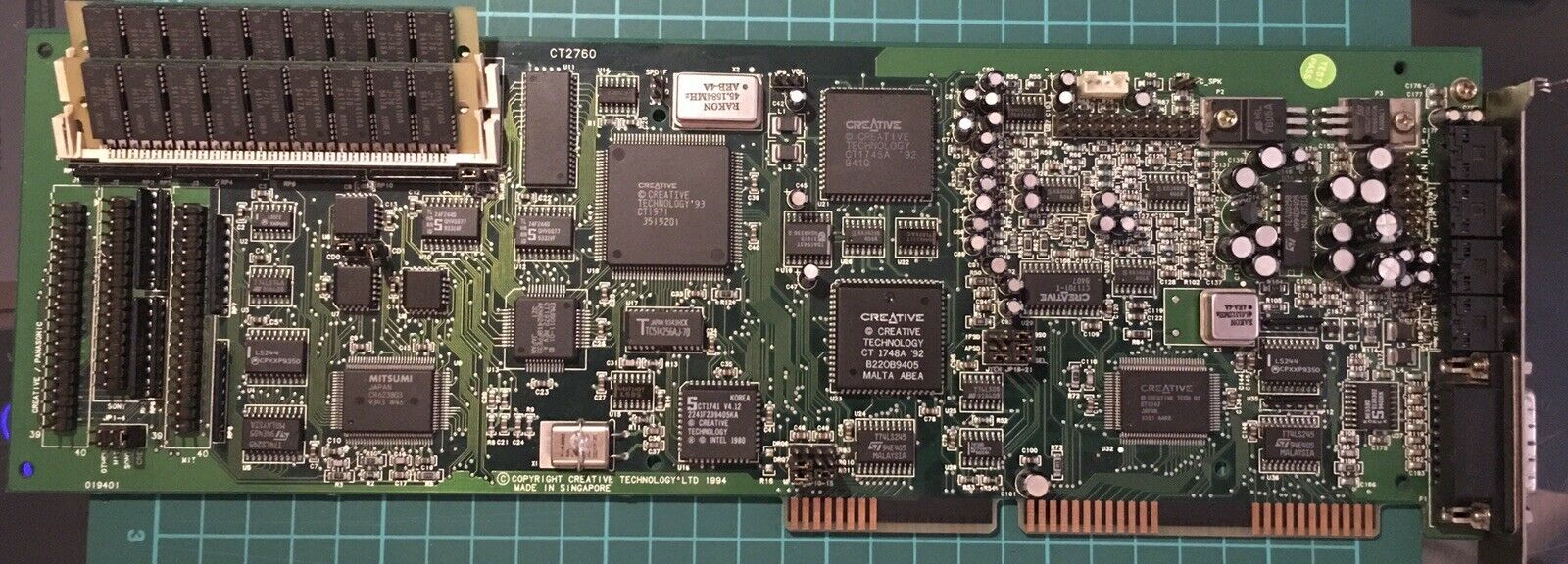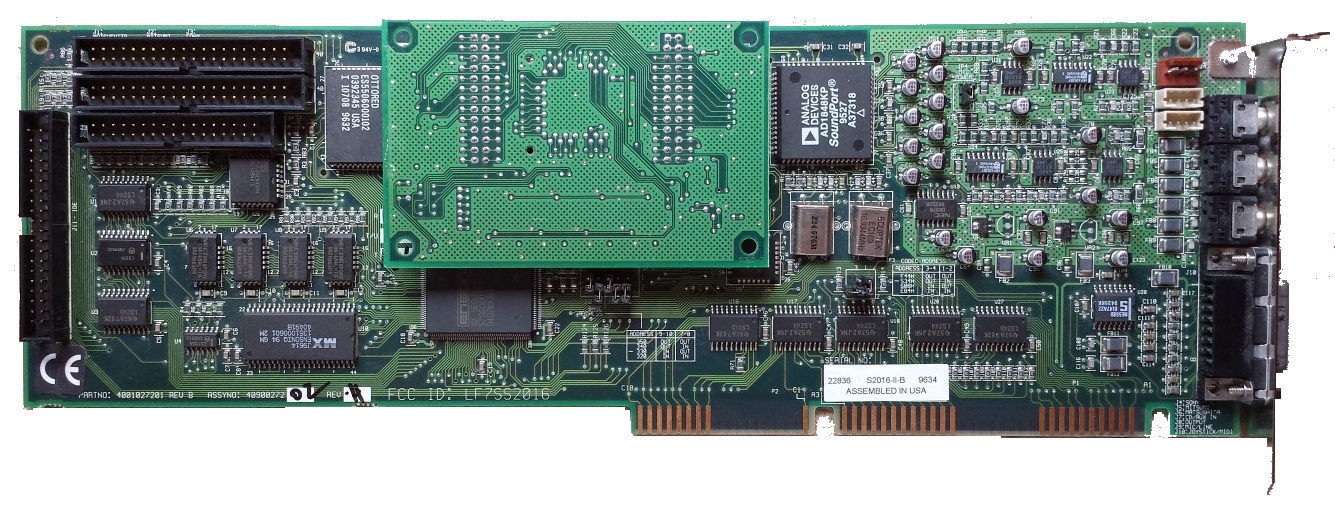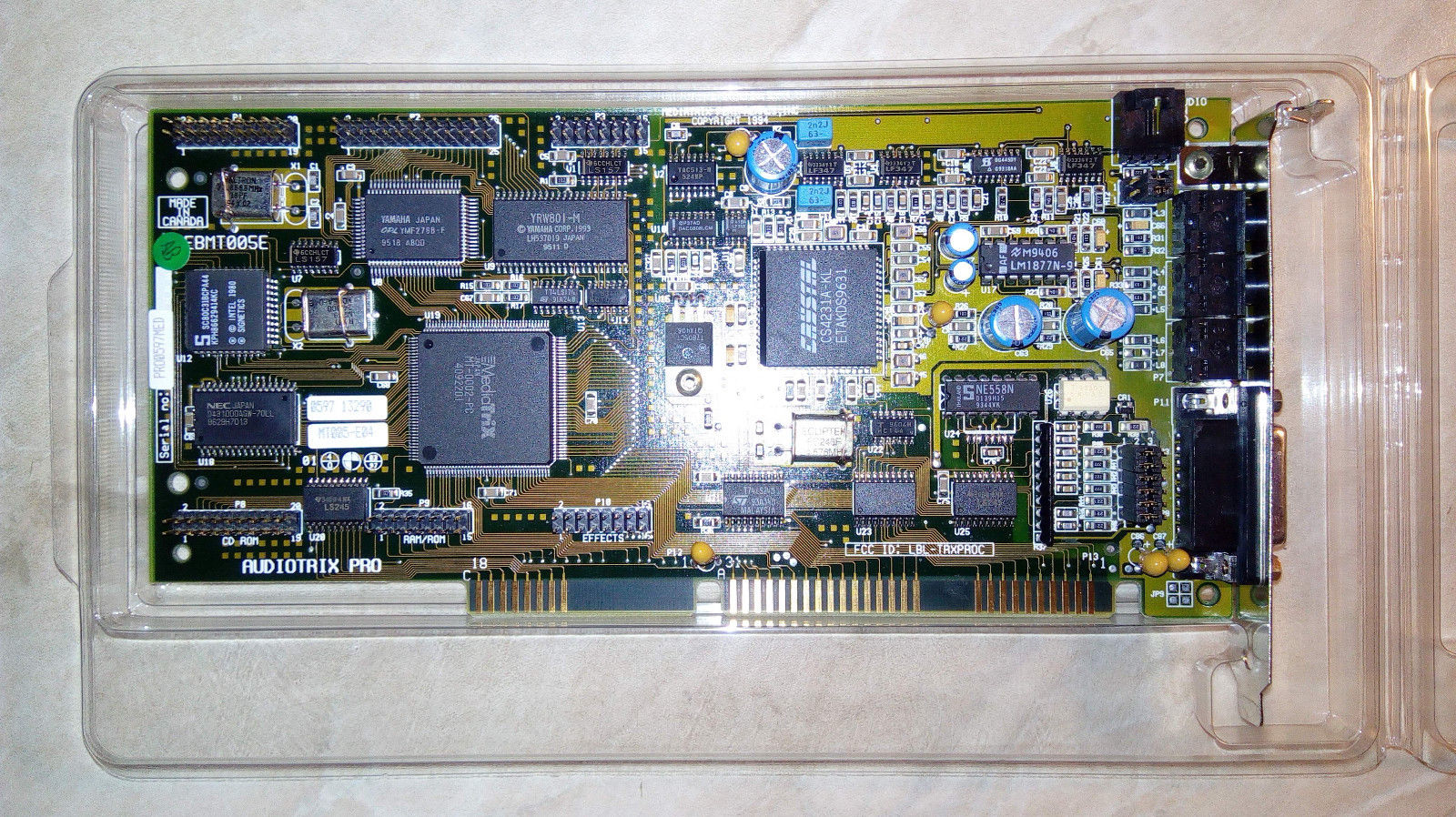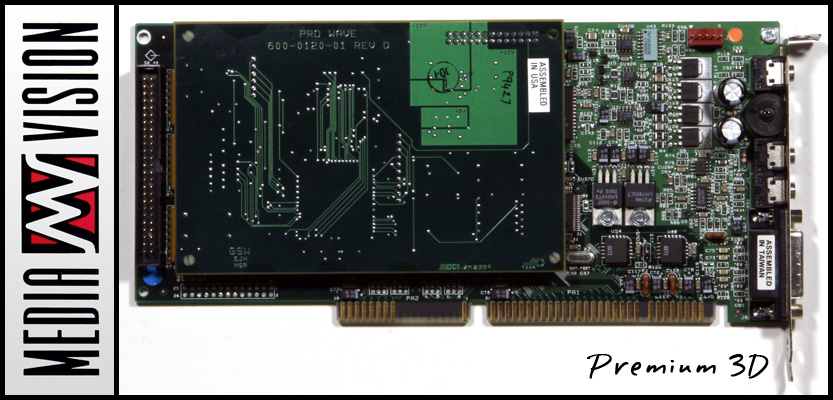The Sound Blaster AWE and Potential Alternatives
9th August 2023
Introduction
There seems to be a keen following among retro PC enthusiasts for the Creative Labs Sound Blaster AWE32 and AWE64. I personally don't understand the logic behind this unless it's what they had back in the day and want to relive the same sound that these cards produced. These days when we have a wealth of alternatives, I find it interesting that these cards still seem in such high demand.

The first Sound Blaster AWE32, model CT2760 (1994)
Creative had a long history of churning out a bewildering array of sound cards, and this saturation of the market coupled with aggressive marketing got their cards into almost every home and business computer. But were they any good? Well, that's very subjective but in my opinion there were just a handful of gems to be found in a sea of dross, and a good number of the AWE range weren't great. In their favour, in 1994 they were competitively priced, and unless you already had a Roland MT-32 or SC-55, Yamaha MU80 or other external General MIDI synthesizer (all of which provided great-sounding audio but at a much higher price point), spending $180 on one of these was a pretty attractive proposition. If you bought a premium PC in 1994 you might have even got one thrown in!
What's Wrong With an AWE?
I have a separate page that takes you through the full AWE model range, so if you're unfamiliar with these sound cards, go there first.
I want to start by listing all the things the AWE32 can and cannot do, and in some cases things that it doesn't do well. I will then offer up some alternative cards that do achieve what the AWE32 and AWE64 should have been all along. I will ignore the price point as it was in the early-to-mid 90s, as I'm assuming you're reading this perhaps with a view to buying one today. AWEs are pretty common but are often overpriced for the actual benefit they provide.
The AWE32 was Creative's first sound card that had an onboard wavetable synthesizer, the EMU8000. This was the same synth they had previously used on their Wave Blaster II daughterboard, which was a decent step up in quality compared to the pretty dreadful first Wave Blaster. The card came with a 1 MB ROM for its instrument samples. In a nutshell you can think of an AWE32 as a Sound Blaster 16 with a built-in Wave Blaster II. Something new to the Creative Labs range was its ability to load your own samples into up to 28 MB of RAM (depending on the actual model variant) through the inclusion of two 30-pin SIMM slots. If these were left unpopulated, the card also had 512 KB of RAM onboard for this same purpose.
Having this ability to load custom samples into RAM wasn't ground-breaking (Creative were rarely the first to market with something new) - Advanced Gravis had released the UltraSound three years earlier with this capability. A little later on cards like the Aureal Vortex and Ensoniq AudioPCI would **only** offer these "software wavetables" which avoided the need for an expensive ROM on the card itself.
The AWE32 was launched at a time when the term "business audio" was everywhere. I interpreted this as meaning "using your sound card and microphone to record voice notes and embed them into documents and presentations". This wasn't something anyone got too excited about back then, and as time would tell, it didn't really go anywhere. That didn't stop sound card manufacturers and OEMs from trying to push it onto the public though as a major new breakthrough. I personally doubt more than a fraction of owners of AWEs ever used its recording capabilities or loaded a custom patchset/SoundFont, so a lot of what these cards could do was probably never used but it helped add a few extra bullet points to put on the spec sheet. Creative weren't alone in this though - all the major sound card manufacturers were advertising advanced recording/editing capability and bundling the appropriate software with the card.
MPU-401 Incompatible and Large Software Drivers
All AWE cards, including the "budget" Sound Blaster 32, used a non-standard interface for MIDI. In March 1994 when the AWE32 was launched, the PC games market was already firmly rooted in its use of the Roland MPU-401 interface for General MIDI. Instead of opting to do the same as everyone else in the audio PC market, Creative chose to make their own. Because this was not standard, in order for the EMU8000 to communicate with a PC on the default MPU-401 port address of 330h, Creative provided a software driver called AWEUTIL that intercepted commands going to this address and redirected them to the EMU8000. The AWE32's box even stated that the MIDI interface was "compatible with Sound Blaster and MPU-401 UART modes", which was kind-of correct but only with the use of software manipulation.
This wouldn't be a problem - just a minor inconvenience - if it weren't for the fact that AWEUTIL was (a) a memory hog which used up to 44 KB of the 640 KB of DOS conventional memory - this could be enough to prevent games from having sufficient free memory to run, and (b) only worked with DOS "real mode" games and their General MIDI option. Protected mode games had to directly support the AWE32 natively for the EMU8000 to work. AWEUTIL also had to be loaded to overcome the "muted OPL3" bug where FM sound wouldn't output at all or you would just get quiet clicking sounds until AWEUTIL was run with the /s command. One workaround for protected mode games is to run the game from within Windows, since the Windows drivers for the AWE range supported protected mode automatically without the need for AWEUTIL to be running.
Incomplete S/PDIF Output
If the purest audio output is important to you, note that only the OPL3 FM output and EMU8000 output is passed to the S/PDIF socket. This means if your plan is to use the Wave Blaster header for your General MIDI output, this will not be heard from your speakers if connected using S/PDIF. The same is true of the CD audio.
Mediocre MIDI and Noisy AWE32s
The EMU8000 didn't really rock anyone's world, especially in 1994 when numerous other wavetable synths were available to choose from, including E-Mu's own Proteus 1/XR, ICS Wavefront 2115, Yamaha YMF278B, Ensoniq's OTTO, and Crystal/Dream's CS9203 and CS9233. This was likely a cost-saving measure, as the Proteus was only found on very high-end sound cards like the Turtle Beach MultiSound. The others, however, were cost-effective alternatives that in most cases had cleaner, richer instrument samples. Rich Heimlich rated the EMU8000 as 'average', scoring its digital quality at a lowly 5 out of 10, and music quality at 6 out of 10. The ICS Wavefront used on the Turtle Beach Rio and Monterey had much better samples in its 4 MB ROM than the EMU8000.
The early AWE32 models also came with an especially noisy DAC. This was replaced with a quieter one in the much later AWE32s and all AWE64 cards. If your ears are good enough to hear all the hiss and noise on a bad 90s sound card, you will likely be disappointed with the AWE32. AWE64 cards are much better in this regard.
Proprietary Memory on AWE64
The AWE32 range is to be praised for its use of off-the-shelf memory sticks - 30-pin SIMMs, and with expansion up to a whopping 28 MB there's more than enough capacity for pretty sizeable SoundFonts. With the AWE64, however, Creative got greedy and changed this expansion capability to a proprietary physical format so you had to buy the memory from Creative Labs - this was costly at the time, and these days it is rare to find them being sold as most owners didn't opt for the RAM upgrade. There is at least one modern adapter that has been produced in small quantities that allows 30-pin SIMMs to work on AWE64 cards.
No Wavetable Header on AWE64
With the AWE64, Creative dropped the wavetable header completely, so you have no option but to use the EMU8000 for wavetable synth audio on these cards.
There are other things I've not mentioned, including the somewhat time-consuming setup and the mix of Plug & Play and non-PnP cards that were offered on these cards.
Better Alternatives
If you can find one (or already own one), the following cards offer less memory usage/no need for TSR drivers, superior wavetable instrument samples, and better quality audio output than the AWE32:
 Ensoniq SoundScape / S-2000 / SPEA Media-FX - this uses the Ensoniq OTTO wavetable synth chip, coupled with either a 1 MB or 2 MB ROM for samples. Regardless of sample ROM size, these cards offer excellent quality instrument samples and a high SnR ratio for quiet audio output. The wavetable can be configured to run in General MIDI mode or Roland MT-32 mode. They also sent fake intelligent mode responses so older MT-32 games that require Intelligent mode (not just UART mode) also work without the need for a true MPU-401 interface. This functionality is rare - I've only counted about 4 other cards that do this.
Ensoniq SoundScape / S-2000 / SPEA Media-FX - this uses the Ensoniq OTTO wavetable synth chip, coupled with either a 1 MB or 2 MB ROM for samples. Regardless of sample ROM size, these cards offer excellent quality instrument samples and a high SnR ratio for quiet audio output. The wavetable can be configured to run in General MIDI mode or Roland MT-32 mode. They also sent fake intelligent mode responses so older MT-32 games that require Intelligent mode (not just UART mode) also work without the need for a true MPU-401 interface. This functionality is rare - I've only counted about 4 other cards that do this.
The only negative point with this card is that it doesn't come with an FM synthesizer chip - instead FM synthesis is emulated through software. Fortunately, the card can be configured for MIDI only so you can use it alongside another FM synth card of your choice for the best of both worlds.
 MediaTrix AudioTrix Pro - this uses the Yamaha YMF278-B (OPL4) wavetable synth and a 2 MB sample ROM chip with instrument patches from Fat Labs. Like the SoundScape, it can be configured for either General MIDI instrument mapping or MT-32 mapping, and also comes with expansion options. It also fakes Intelligent mode commands like the SoundScape.
MediaTrix AudioTrix Pro - this uses the Yamaha YMF278-B (OPL4) wavetable synth and a 2 MB sample ROM chip with instrument patches from Fat Labs. Like the SoundScape, it can be configured for either General MIDI instrument mapping or MT-32 mapping, and also comes with expansion options. It also fakes Intelligent mode commands like the SoundScape.
Rich Heimlich said of this card: "Best OPL4 patch set. Solid Windows card. Solid SB/FM support. Low noise. Supports ADPCM. Very good one-card solution but a bit on the expensive side especially if you add the optional CD-ROM interface, RAM DB, Effects module or other options. SB-Pro support would help.". He scored it 8.0 out of 10 for digital quality but only 6.5 out of 10 for music quality due to its use of the Crystal CS4231A-KL for FM synthesis.
 MediaVision Pro 3D - Built on their ProAudio Spectrum 16 technology, MediaVision's Pro 3D card used their new Jazz16 chipset coupled with a Korg Pro Wave wavetable daughterboard which provided some of the best instrument samples money could buy in 1994. They also did a Premium 3D (pictured) which was sold without the wavetable daughterboard.
MediaVision Pro 3D - Built on their ProAudio Spectrum 16 technology, MediaVision's Pro 3D card used their new Jazz16 chipset coupled with a Korg Pro Wave wavetable daughterboard which provided some of the best instrument samples money could buy in 1994. They also did a Premium 3D (pictured) which was sold without the wavetable daughterboard.
Rich Heimlich said this of the Pro 3D card: "One of the best single card solutions available. Includes nice creature comforts like built-in SRS and a basic effects processor. It's also SB-Pro compatible. My biggest problems are the lack of a supportable 16-bit mode and the need to use a 6k TSR. Should prove to be a nice Windows 95 card. The Premium 3-D is the same card without the Korg AI2-based daughterboard.". His scores were 7.5 for digital quality and 7.0 for music quality (out of 10).
- Other Stereo Cards with a Wavetable Daughterboard - For PC gaming, remember that the vast majority of games only used 22 kHz 8-bit digital samples. It is for this reason that the Sound Blaster Pro and compatibles are often considered a better choice than a Sound Blaster 16, which offered 16-bit recording and playback if you had software/games that would fully utilise it, but could only output monaural sound in SBPro modes due to a flaw in the chip design). Most Sound Blaster Pro-compatible sound cards come with a wavetable header, so this opens up a great many more options to combine decent stereo sound effects with potentially excellent quality wavetable synthesis for music.
My recommendation is to find a good-quality Sound Blaster Pro-compatible card with a real Yamaha OPL3 chip and attach a wavetable daughterboard to it. For the card itself, a modern-day Orpheus II is a great option with very low noise, a real OPL3 chip with SBPro compatibility and a wavetable header.
Sadly, original wavetable daughterboards from the 90s are a pretty rare find these days, and when they do come up for sale their sellers are usually looking for exorbitant sums of money for them. There are, however, modern-day daughterboards that have been produced which offer anywhere from good to excellent quality samples. Some examples of good ones are the DreamBlaster X2GS and DreamBlaster X16. both of which are based on the Dream SAM 5000-series synth. The X2GS comes with a 16 MB sample ROM whereas the X16 comes with a 1 GB flash for sample storage which you can flash from USB.
I hope you enjoyed this article, and as always I welcome any feedback - both positive and negative. Just use the Contact Us page to send me a message.